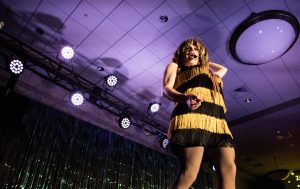Colonnade used to be place to watch pigskin fly
October 24, 2002
Dero Downing remembers a day when fans walked uphill to watch football games.
The old football stadium at the Colonnade sat in the heart of campus. It was the place to be on Saturday afternoons. Built on the side of a cliff, the stands overlooked Southern Bowling Green.
Today, the field and lights are gone. The only remainder of the old stadium is the aluminum seating area.
Multi-use facility
The old stadium was finished in November 1927 for $50,000. It replaced a limestone quarry on the northeast side of campus.
To build a stadium on a quarry, hundreds of loads of dirt were dumped in the hole.
Stones from the limestone quarry were used to build Whitestone Hall, now Schneider, and acted as a foundation for the stadium seats.
Lights were installed in 1946 and metal bleachers replaced wooden ones in 1963.
The lights cost $15,000 and were the same type installed in New York’s Yankee Stadium.
Since those days, there has been just one major renovation. In 1998, $30,000 was spent to pressure wash the bleachers. Bathrooms were also repainted and new plumbing installed.
But the stadium was used for more than just football. Baseball, track, ROTC and graduation ceremonies were also held there.
“One of the most beautiful exercises on campus was the graduation ceremony under the lights at the old stadium,” Downing said. “Absolutely gorgeous.”
Lowell Harrison, a former Western professor and historian, said it was like being on a cliff.
“You just sit up there and look out at the south across Bowling Green,” he said. “It was almost entirely farm land.”
Playing in the colonnade
It was the ultimate home court advantage. The stadium itself was intimidating to outsiders, perched on the side of a cliff but right at the heart of campus.
The football team’s first game in the colonnade was against Bethel College on Oct. 8, 1927. Behind the coaching of E.A. Diddle, the Teachers College won 61-0.
Season tickets for five games that year sold for $4.
Players said weather affected the field since it was built on a cliff.
Because of the way the stadium was positioned, looking in one direction was almost blinding. It left visiting teams paralyzed.
“When the sun would come out after a rain, the sun would act like a brick,” said Robert Simpson, who graduated in 1953 and played tight end and cornerback. “We’d get some teams down there and run them against the brick. They didn’t like that.”
In addition to the sunlight, the crowds offered a home field advantage. Downing said the bleachers were packed during almost every game. Everyone walked, so they didn’t need to worry about parking.
“Places, sort of like people, have a personality and that place had a sort of personality about it,” he said.
Some of the most exciting games were against rivals, such as Eastern Kentucky.
One game stands out for Downing.
It was 1951, and Western’s quarterback was junior Jimmy Feix. The Toppers were trailing Eastern on Homecoming with only a few seconds on the clock.
“The reason I remember it so well is the Eastern folks were gathering up their notes and paraphernalia,” Downing said about the Colonels confidence. “Western had the ball on the 40-yard line, and Feix threw a long pass to Max Stevens for a touchdown.”
Feix, a 1952 All-American and later football coach and athletics director, said another memorable play came from Gene McFadden against East Tennessee State in 1953. He ran 96 yards on a trap play. It was a school record until 1986.
Time to Move
The university faced major growth during the sixties. Academic buildings and dorms were popping up on the Hill. Aside from the football field, only two dorms remained at the top of the hill – Potter and Whitestone Hall, later renamed Schneider.
The football field had to be moved.
Downing said the field had to be moved in order to accommodate a need.
“It was another step in relocating a major activity to better accommodate the future needs of the university,” Downing said.
“That property became so valuable as an academic site, they needed the field for academic growth,” Feix said. “We got a new stadium out of the deal. We didn’t get a new stadium because we needed a new stadium.”
The Toppers played their last game in the colonnades in 1967. In 1968, they greeted Smith Stadium. The building offered more space for classrooms, faculty offices, weight rooms and sports medicine facilities. Its original capacity was 19,250, but now holds 17,500.
“It was a very nice stadium to give up,” Harrison said. “By the time they moved it, it was almost in the heart of campus. It just couldn’t handle the crowds. You moved away from a very charming location.”
Reach Keith Farner at [email protected].





















![Megan Inman of Tennessee cries after embracing Drag performer and transgender advocate Jasmine St. James at the 9th Annual WKU Housing and Residence Life Drag Show at Knicely Conference Center on April 4, 2024. “[The community] was so warm and welcoming when I came out, if it wasn’t for the queens I wouldn’t be here,” Inman said.](https://wkuherald.com/wp-content/uploads/2024/04/smith_von_drag_3-600x419.jpg)


